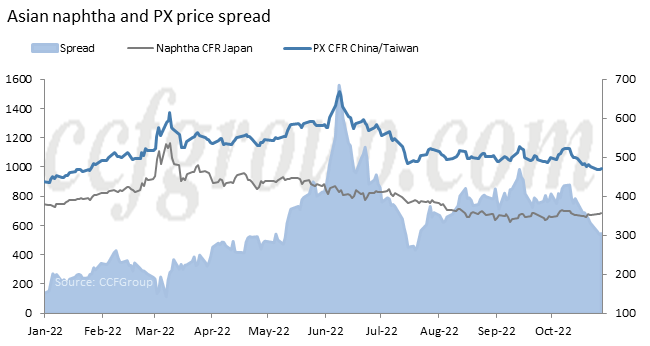PX supply and demand amid expectation of new plants
Recently, the progress of new PX plants draws much attention.
1. Dongying Weilian is preparing the startup of its Phase II new 2.2 million mt/yr reformer and conducting pre-hydrogenation. The new plant is poised to begin PX and benzene production, with capacity of 1 million mt/yr and 300kt/yr respectively in mid-Nov or late Nov.
2. Shenghong Refining’s new plant is said to have achieved on-spec PX during the trial run of PX unit with purchased feedstock MX, according to CCFGroup’s investigation. However, the startup date of the new refinery has not been announced. When the refinery starts, it will soon get PX production.
3. PetroChina Guangdong has input crude oil to its CDU unit. It is expected to begin trial run in early Nov, and may start production in end-Nov or early Dec. The new plant is expected to get PX in late Dec or end-Dec, with capacity of 2.6 million mt/yr.
Despite the progress, the three new plants are unlikely to exert substantial impact on PX supply in China market for the rest of 2022.
In sync with the Phase II new PX plant, Dongying Weilian is also scheduled to start its new 2.5 million mt/yr PTA plant in late Nov. Therefore, PX production from the new plant would not be directly sold to the market, but instead, the sales of PX production from Phase I may get reduced, and the new plant would impact the market with increasing PTA production.
Shenghong’s new PX plant could also provide supplies for internal application, while the volume of PX for sale could be limited in 2022. PetroChina Guangdong is slated to begin PX production in late Dec with stocking requirements, while its selling volume in 2022 could also be minimal.
In a conclusion, in the fourth quarter of 2022, PX supply is expected to increase slightly in a gradual pace. China domestic production is estimated at around 2.1 million tons a month in Oct and Nov. Then, the monthly production may augment to 2.3 million tons in Dec, with contribution from new plants, as well as restarts of Sinopec ZRCC and Sinopec HRCC.
In terms of imports, Asian PX supply is under strains from high MX prices denominated in US dollar. As US MX price hikes, Asia to US arbitrage window opens again, driving up Asian MX prices. With MX higher priced than PX on FOB Korea basis, Asian PX supply could be impacted and China’s PX imports could also get affected.
As for PTA, with new PX and PTA plants starting, PTA production would increase, as Dongying Weilian’s new plant is expected to start production and some PTA plants would keep operations uninterrupted with tight feedstock PX relieved. The increase in PTA production in mid-Nov or late Nov could be obvious without taking into account of unexpected cuts. As polyester inventory is high while profit is meager, and polyester plants may reduce inventory prior to the Spring Festival in Jan, demand from polyester is expected to shrink.
Therefore, despite of slow growth in PX and PTA production, PX-naphtha and PTA-PX spread are both weak, responding to the upcoming new plants. Dec PX goods were bid at premium of $35/mt to formula price, however, PX-naphtha spread has narrowed from $400/mt in early Oct to around $300/mt, down by 25%. As for PTA, though PTA-PX processing spread widened recently, spot-futures spread has dropped from 800yuan/mt in early Oct to below 600yuan/mt.


In the future, as long as polymerization rate does not decline rapidly, PTA and PX supply is expected to keep tight in the short term. However, opportunities for long position investors are limited and the profits have weakened. Any demand change should be watched closely.
- Top keywords
- Cotton Price
- Cotton Futures Price
- Cotton Futures
- CZCE
- PTA Futures Price
- Chemical Fiber
- Polyester Prices
- Wool price
- PTA Futures
- Shengze Silk
- China
- Yarn Price
- price
- China Textile City
- Fibre Price
- Benzene Price
- Cotton
- Index
- Cotton Index
- PTA
- fabric price
- NYMEX
- Top 10
- textile industry
- Spot Cotton
- Cotton Yarn
- Polyester Price
- Futures
- PTA Price
- cotton yarn price

